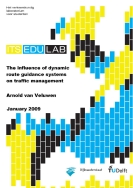At the end of 2007 a new route guidance application for individual road travellers became available: a dynamic route guidance system (DRGS). Dynamic route guidance systems, which do incorporate traffic information, could improve route choice and travel times. However, if a significant amount of travellers will use these systems, the advantage of getting information is decreasing. Besides that, it is questionable to what extent these system are capable of informing the travellers accurate and moreover what are the consequences of non-accurate and imperfect information. A third aspect is, that it is unlikely that all equipped travellers will fully follow the advice provided by the dynamic route guidance system. With a model some theoretical aspects were researched: the influence of the penetration rate, the quality of the traffic information and the influence of the compliance behaviour. The general result is that there is an optimal situation, where all travellers together in the system benefit most. The advantages for the users of the dynamic route guidance system decrease as the penetration rates increases, however due to a more efficient route choice of these equipped travellers also the non-users benefit from that. The optimal situation is dependent on the network. For the Rotterdam network, it turns out that the optimal social point is around 25%-30% penetration.

|
Publication date:
January 21, 2009 Download report: MSc_Thesis_Arnold_van_Veluwen Research topic: Traffic information Research question: Impact of in-car traffic information Project: Impact of in-car traffic information |